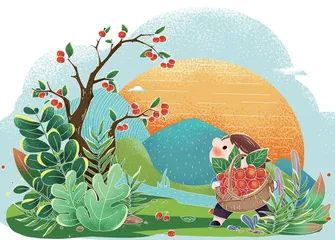文化万花筒 二十四节气(二)
作者: 许林玉

上期,我们介绍了二十四节气的起源、分类和应用等。本期,我们将逐一介绍二十四节气与天气变化、农业生产之间的关系。
February 4, the opening day of the 24th Winter Olympic Games, was thisyear’s “Lichun”, or the beginning of spring, the first of the 24 solar terms of thetraditional lunar Chinese calendar that was an 1)inspiration behind the ceremony.
The second solar term of the year is “Yushui”, or rain water. The rain isvital for the growth of crops and other flora. From that day on, the rainfall increasesto 2)nourish the land. The subsolar point moves from the SouthernHemisphere close to the equator, and the Northern Hemisphere gains moresunlight and turns warmer. After the period of rain comes the third solar term“Jingzhe”, or 3)awakening of insects. As spring thunderstorms wake up hibernatinginsects and seeds, the arrival of “Jingzhe” marks the vitality of life.
When “Chunfen”, or spring equinox, arrives, the sun is exactly at the celestiallongitude of 0 degrees (the equator) and day and night are approximatelyequal in length.
“Qingming” (pure brightness) and “Guyu” (grain rain) are the last two solarterms of spring. Both of them describe a warmer, moister and greener land.“Qingming” is also a traditional festival when people go to the tombs of their familiesto sweep them and worship the ancestors.
“Lixia”, or the beginning of summer, falls on May 5 this year. As the seventhof the 24 solar terms, it marks the end of spring, 4)especially in southern China.
词组加油站
be vital for 对……是至关重要的
be equal in 在某方面相等
fall on 降临;落到
The second solar term of summer is “Xiaoman”, or grain buds. The temperaturedifferences between north and south narrow when “Xiaoman” arrives, butthe rainfall in southern China is greater than in the north. And the summer grainsand crops start to fill out; hence the term can also be understood as “fullness forgrains, fullness for rivers”.
The summer planting starts at “Mangzhong”, or grain in ear. Fields, wheatseedlings, quiet mountains and singing birds offer the best interpretation of thisperiod.
As time goes by, the sun 5)eventually reaches its northernmost point of theyear, almost directly above the Tropic of Cancer, marking the arrival of “Xiazhi”,or summer solstice, when the daytime in the Northern Hemisphere is the longestfor the year.
“Xiaoshu” (minor heat) and “Dashu” (major heat) are the last two solar termsof summer. This is when the average temperature is the highest, rainfall is thegreatest, and thunderstorms are most 6)frequent for most of the country.
“Liqiu”, or the beginning of autumn will arrive on August 7 this year. Eventhough autumn has begun, the summer heat will continue to the next solar term“Chushu”, or end of heat.
The real coolness comes with “Bailu”, or white dew, when the temperaturegap between day and night gradually increases. Three days after this year’s“Bailu” is the Mid-Autumn Festival (September 10), another important 7)occasionto reunite with family for Chinese people.
“Qiufen”, or autumn equinox, is the same as “Chunfen” (spring equinox)when day and night equally divide the whole day. Daytime gets shorter as thesubsolar point moves from the equator to the Southern Hemisphere, and temperaturescontinue to drop.
“Hanlu” (cold dew) and “Shuangjiang” (frost’s descent) mean the weather isgradually reach dew point, and then to frost point. It’s an early warning of winter.
Autumn leaves, winter comes, and time flies. November 7 is this year’s “Lidong”,or the beginning of winter.
“Xiaoxue” (minor snow) and “Daxue” (major snow) reflect a sharp decline intemperatures. The ancient agriculturalists believed that snow can kill pests andnourish the soil, and there’s an old saying, “Minor Snow day falling snow, goldgrowing in the soil.”
“Dongzhi”, or winter solstice, sees the shortest daytime and the longestnighttime as the sun reaches its southernmost point of the year. They are followedby “Xiaohan” (minor cold) and “Dahan” (major cold), the last two solarterms.
今年2 月4 日,即第24 届冬季奥林匹克运动会开幕式当天,正值“立春”。这是中国传统农历二十四节气中的第一个节气,北京冬奥会开幕式倒计时的灵感正是来源于此。
“雨水”是一年中的第二个节气。雨水对农作物和其他植物的生长至关重要。从这一天起,降雨量增加,土地因此得到滋养。日下点从南半球移至赤道附近,北半球阳光更加充足,因此会变得更为温暖。雨水期过后是第三个节气“惊蛰”。春雷唤醒冬眠的昆虫和种子,随着“惊蛰”的来临,生命的活力开始涌动。
“春分”到来之际,太阳正好位于黄经0度(赤道),昼夜时长大致相等。
“清明”和“谷雨”是春季的最后两个节气。此时大地温润,草木葱茏。清明也是一个传统节日,人们在这一天清扫墓地,祭拜祖先。
今年的“立夏”在5月5日。作为二十四节气中的第七个节气,它标志着春天的结束,尤其是在中国南方地区。
夏季的第二个节气是“小满”。“小满”到来时,南北温差缩小,但中国南方的降雨量较北方大。谷物等农作物开始变得饱满。因此,该节气也可以理解为“谷物饱满,河水丰盈”。
夏季播种从“芒种”开始。田野、麦苗、幽静的山峦和鸣唱的鸟儿,是对这一时节最好的诠释。
随着时间的推移,太阳最终到达一年中的最北端,几乎位于北回归线正上方。这标志着“夏至”的到来,此时北半球的白昼时间达到全年最长。
“小暑”和“大暑”是夏季的最后两个节气。此时平均气温最高,降雨量最大,大部分地区的雷雨天气最为频繁。
今年的“立秋”在8月7日。尽管秋天已至,但暑热仍将持续至下一节气——“处暑”。
到了“白露”,天气真正凉爽起来,此时昼夜温差逐渐加大。今年的“白露”过去三天之后(9月10 日)便是中秋节,这是中国人与家人团聚的另一个重要时刻。
与“春分”一样,在“秋分”这一天,昼夜平分。随着日下点从赤道向南半球移动,白天变得越来越短,气温也持续下降。
“寒露”和“霜降”意味着天气逐渐达到露点,然后达到霜点。这是冬天来临的前兆。
时光飞逝,秋去冬来。今年的“立冬”在11月7日,冬季自此开始。
“小雪”和“大雪”反映了气温的急剧下降。古代农学家认为,雪可以杀灭害虫,滋养土壤。俗话说:“小雪雪满天,来年必丰年。”
“冬至”这一天,太阳到达一年中的最南端。此时白昼最短,夜晚最长。接下来是最后两个节气——“小寒”和“大寒”。